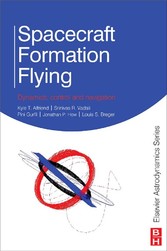Search and Find
Service
Front cover
1
Half title page
2
Title page
4
Copyright page
5
Dedication
6
Table of Contents
10
Foreword
14
Preface
16
Chapter 1. Introduction
22
1.1. What is Spacecraft Formation Flying?
22
1.2. Coordination Approaches
23
1.3. Fuel-use Drivers
24
1.4. Control of Spacecraft Formations
25
1.5. Control Approaches
26
1.6. Space Navigation and the Global Positioning System
28
1.7. Formation Flying Missions
29
Chapter 2. Fundamental Astrodynamics
34
2.1. Coordinate Systems
35
2.2. The Keplerian Two-body Problem
37
2.3. Solution of the Inertial Equations of Motion
43
2.4. Nonsingular Orbital Elements
46
2.5. Non-Keplerian Motion and Orbital Perturbations
49
2.6. Averaging Theory
57
Chapter 3. The Basics of Analytical Mechanics, Optimization, Control and Estimation
60
3.1. Lagrangian and Hamiltonian Mechanics
60
3.2. The Delaunay Elements
62
3.3. Canonical Transformations
63
3.4. Brouwer Theory
64
3.5. Constrained Static Optimization
67
3.6. Control Lyapunov Functions
68
3.7. Linear Quadratic Regulation
69
3.8. Kalman Filtering
70
3.9. The Unscented Kalman Filter
73
Chapter 4. Nonlinear Models of Relative Dynamics
80
4.1. Equations of Relative Motion in the Unperturbed Case
81
4.2. The Energy Matching Condition
85
4.3. Impulsive Formation-keeping
87
4.4. Another Outlook on Optimal Formation-keeping
93
4.5. Circular Chief Orbit
95
4.6. Lagrangian and Hamiltonian Derivations
97
4.7. Equations of Relative Motion under the Influence of J2
99
Chapter 5. Linear Equations of Relative Motion
104
5.1. The Clohessy--Wiltshire Equations
105
5.2. Two-impulse Linear Rendezvous
111
5.3. Lagrangian and Hamiltonian Derivations of the CW Equations
115
5.4. Accommodating second-order nonlinearities
118
5.5. Curvilinear vs. Cartesian Relative Coordinates
120
5.6. Elliptic Reference Orbits
124
5.7. Periodic Solutions to the TH Equations
138
Chapter 6. Modeling Relative Motion Using Orbital Elements
144
6.1. General Solution to the Nonlinear Relative Motion Equations
145
6.2. Bounds on Maximal and Minimal Distances
149
6.3. Relative Motion Approximations with a Circular-Equatorial Reference Orbit
150
6.4. Establishing the PCO Initial Conditions
157
6.5. Hybrid Differential Equations with Non-linearity Compensation for Unperturbed Circular Orbits
159
Chapter 7. Modeling Perturbed Relative Motion Using Orbital Elements
164
7.1. The Unit-Sphere Approach
164
7.2. Relative Motion Description using Quaternions
168
7.3. The Gim--Alfriend Geometric Method
171
7.4. Averaged Relative Motion
186
7.5. Linearized J2 -Differential Equations for Circular Orbits
190
7.6. Differential Equations from the Gim--Alfriend STM
197
7.7. A Second-Order State Propagation Model
201
Chapter 8. Perturbation Mitigation
206
8.1. Dynamic Constraints for J2 Mitigation
206
8.2. A Nonlinear Theory based on Orbital Elements
220
8.3. Dynamic Model Error Effect Comparison
227
8.4. Perturbed Fundamental Frequencies for Formations in Near-circular Orbits
233
8.5. Selection of the PCO Initial Conditions for Near-Circular Orbits
235
8.6. Matching the In-plane and Cross-track Fundamental Frequencies
237
8.7. PCO Formation Maintenance based on the Modified CW Equations
240
8.8. Fuel Minimization and Balancing
243
Chapter 9. Rotation-Translation Coupling
248
9.1. Relative Dynamics
249
9.2. Kinematically-Coupled Relative Spacecraft Motion Model
253
Chapter 10. Formation Control
262
10.1. Continuous Control
262
10.2. Discrete-time LQR Control
270
10.3. Impulsive Control based on Gauss' Variational Equations
273
10.4. Two-impulse Formation Reconfiguration for Circular Orbits
277
10.5. Two-impulse-per-orbit Formation Maintenance
278
Chapter 11. Implementation of . v Commands
292
11.1. Plan Implementation
293
11.2. Impact on Autonomous Rendezvous and Docking
300
Chapter 12. Relative Measurements and Navigation
308
12.1. Dynamical Modeling
309
12.2. Measurement Update: Carrier-Phase Differential GPS
311
12.3. Comparison of EKF and UKF for Relative Navigation
314
Chapter 13. High-Fidelity Formation Flying Simulation
326
13.1. Simulation Controller Configuration
327
13.2. Simulation Results
329
Chapter 14. Summary and Future Prospects
350
14.1. Risk Reduction
350
14.2. Fuel Requirements
351
14.3. Mission Operations
351
Appendices
352
A. The Transformation Matrix S (t)
352
B. The Transformation Matrix S (t) - 1
353
C. The Matrix B (t)
355
D. The State Transition Matrix for Relative Mean Elements
356
E. Transformation from Mean to Osculating Elements
359
F. Jacobian for Mean to Osculating Elements
362
G. Small Eccentricity Theory
372
H. Yan-Alfriend Nonlinear Theory Coefficients
378
References
384
Index
400
All prices incl. VAT














